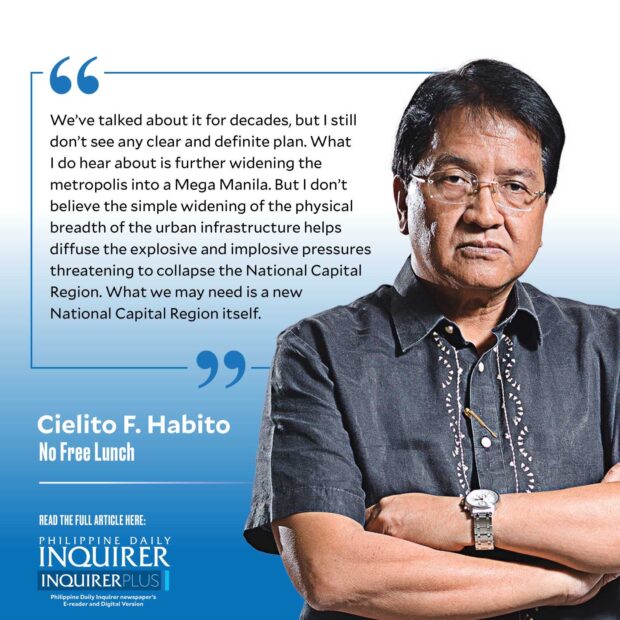A new national capital?
 Metro Manila is both exploding and imploding,” mused my environmentalist colleague Dr. Ben Malayang III, as members of our small chat group compared notes on traffic jam experiences two weeks ago, amidst widespread flooding in the city. Lory Tan, who used to lead WWF (World Wide Fund for Nature)-Philippines, had messaged us all earlier: “SLEx (South Luzon Expressway) Bicutan area is flooded and both north- and southbound are experiencing almost standstill traffic. Extent of southbound traffic has now reached Paco in Osmeña Highway.” He added: “Last night, Merville/Moonwalk was a river. Today, Bicutan is a lake.”
Metro Manila is both exploding and imploding,” mused my environmentalist colleague Dr. Ben Malayang III, as members of our small chat group compared notes on traffic jam experiences two weeks ago, amidst widespread flooding in the city. Lory Tan, who used to lead WWF (World Wide Fund for Nature)-Philippines, had messaged us all earlier: “SLEx (South Luzon Expressway) Bicutan area is flooded and both north- and southbound are experiencing almost standstill traffic. Extent of southbound traffic has now reached Paco in Osmeña Highway.” He added: “Last night, Merville/Moonwalk was a river. Today, Bicutan is a lake.”
“Yes, my daughter has been stuck at SLEx and Skyway for hours,” I chimed in. She had left our home in Los Baños at 9 a.m. to catch an 11 a.m. appointment in Taguig, but was still stuck crawling along the Skyway as of 12:30 p.m. She finally made it to her meeting past 1 p.m., over two hours late. Ben volunteered his own experience the night before: “My 7 p.m. flight from Naia was able to leave at 11:40. Rain and lightning alerts delayed most if not all flights. One was diverted to Clark.” Lory noted: “That wasn’t even a typhoon. Just LPA (low-pressure area) and Habagat”—and added: “Celsius. Carbon. Congestion. All in one night.” He was alluding to the white paper our think tank Brain Trust Inc. released in 2020, wherein we characterized the climate crisis as revolving around five interlinked Cs, the other two being Contagion and Consumption (see “People and planet in peril,” 7/3/2020).
We agreed it’s another classic failure in planning—in this case lack of proper attention to drainage systems. My agricultural engineering professor in college used to stress how drainage demands as much attention as irrigation in farm systems planning (his course was titled “Irrigation and Drainage”), but is too often neglected, even ignored. The same would apply to urban planning as well, and our massive failure in it has inflicted a heavy economic and human welfare toll on Filipinos year in and year out, for far too long. This is where Ben noted that Metro Manila is both exploding, because of its population, and imploding, because of weak institutions.
As we chatted, Lory brought up the need to move things out of Metro Manila. I mentioned that Myanmar created its new capital Nay Pyi Taw long before problems with congestion in its traditional capital Yangon came anywhere near those in Metro Manila. So with Malaysia’s Putrajaya, which has kept Kuala Lumpur lower in the list of the notoriously traffic-choked capitals in the region.
Ben summed up our predicament thus: “Increased (population) density convolutes regulatory systems and the demand for services. Transaction costs of public service and governance soar, and in a country with persistently low narrow fiscal space, governance implodes and the vulnerability of the population to environmental and political stresses escalates and intensifies. Floods, pollution, and health risks become more difficult to control, and providing ample food and good nutrition gets costlier.” In short, Metro Manila is falling into an ever-deepening spiral, and something has to be done to arrest it.
Our resident culture and arts expert, Marian Pastor-Roces, chimed in: “And because the Metro Manila Development Authority does not have governor-level authority, it is unable to assert a macro perspective in relation to the political fiefdoms that are our Metro Manila cities.” Do we need another Imelda Marcos reigning as governor of Metro Manila and cracking the whip on the city mayors, for Metro Manila to shape up? Or might it be easier and better to shift the nation’s political capital north (to Central Luzon) or south (to Calabarzon), so that decongestion can truly begin to happen?
We’ve talked about it for decades, but I still don’t see any clear and definite plan. What I do hear about is further widening the metropolis into a Mega Manila. But I don’t believe the simple widening of the physical breadth of the urban infrastructure helps diffuse the explosive and implosive pressures threatening to collapse the National Capital Region. What we may need is a new National Capital Region itself.
cielito.habito@gmail.com




















